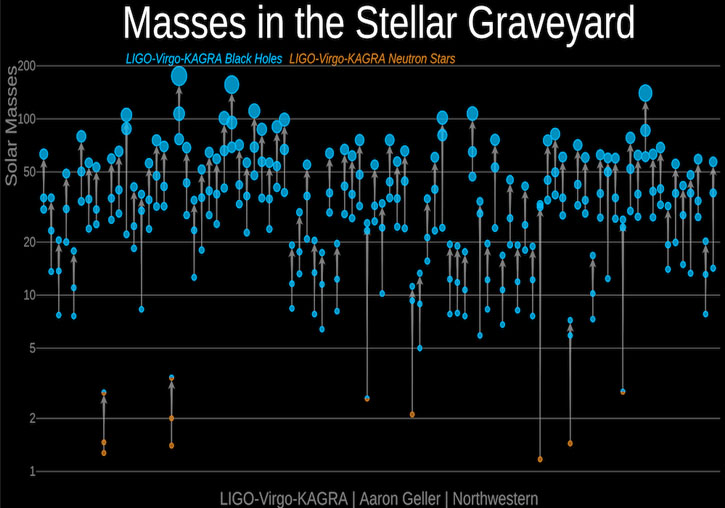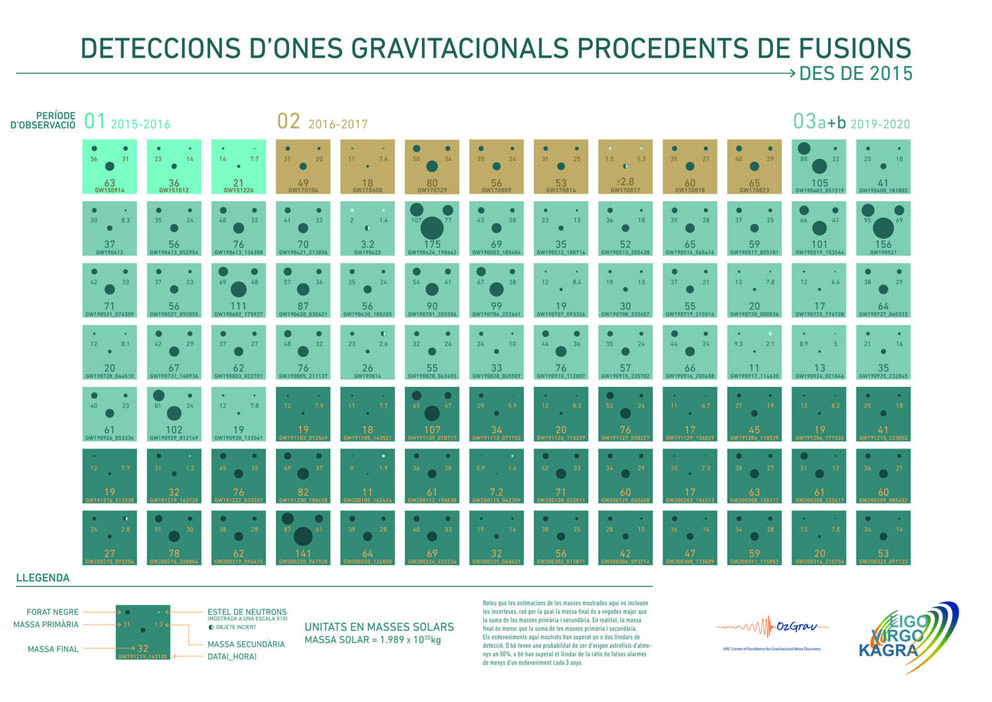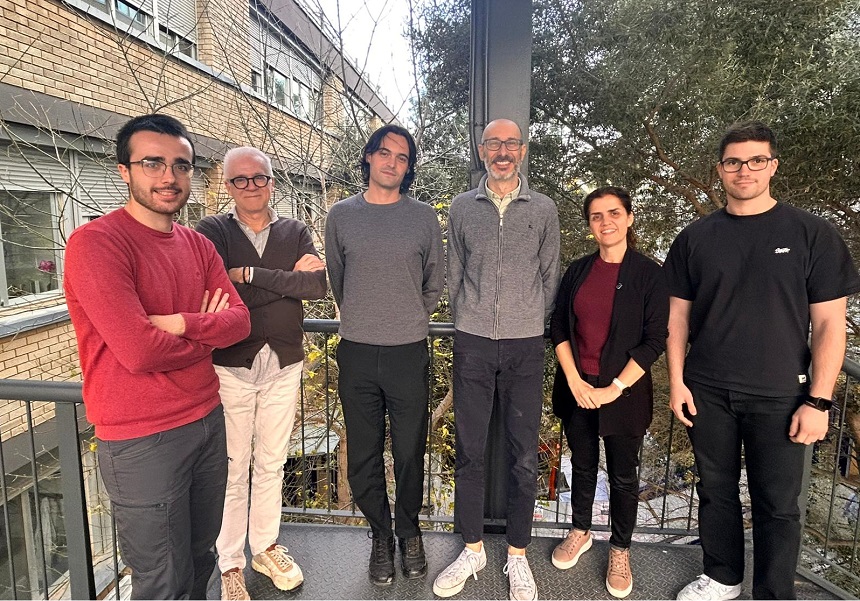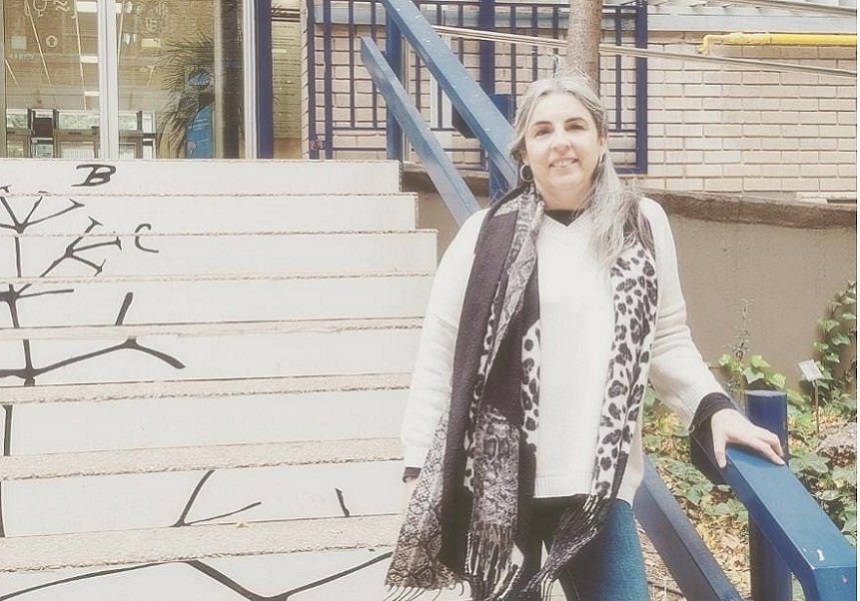International LIGO-Virgo-KAGRA Collaboration Detects 35 New Gravitational Wave Events
- Scientific Culture and Innovation Unit
- November 9th, 2021

The international collaboration LIGO-Virgo-KAGRA, in which the University of Valencia and five other Spanish groups participate, has increased the number of gravitational waves detected to date to 90, as a consequence of the last observation period of 35 new events. These are spacetime quakes generated by the mergers of either two black holes or neutron stars, as well as black hole-neutron star pairs.
The dataset, published this Monday in the ArXiv online repository, in the article so-called third Catalogue Paper, outlines the features of new populations of black holes, the masses of which, together with those of the observed neutron stars, provide clues about how stars live and die, further broadening the horizons of gravitational astronomy. The 35 new gravitational wave events were observed between November 2019 and March 2020, during the second part of the third and most recent observation period (03b).
“The new catalogue that the LIGO-Virgo-KAGRA collaboration has just announced raises to 90 the gravitational signals detected since the historic first detection of September 14, 2015. With the increase in detections motivated by the improvement in the sensitivity of the detectors, also increases the diversity of the compact binaries that originate the signals, which provides unprecedented information on the properties of black holes and neutron stars”, says José Antonio Font, coordinator of the Virgo group in Valencia and professor of Astronomy and Astrophysics from the University of Valencia.
“However, the presence in this new catalogue of systems that are comparatively more extreme than in previous catalogues, poses enormous challenges to the theoretical modelling of the waveforms with which the physical properties of the sources are inferred, difficulties that will become even greater during the next O4 observation campaign. The line of research dedicated to the numerical obtaining of waveform models, such as the one carried out by the group at the University of Valencia, should redouble its efforts to be able to provide waveform models capable of accommodating fusions of compact, non quasi-circular objects and with significant orbital eccentricity”, concludes Font.
Most of the new signals come from the spiral phase of the merger of two black holes: cosmic earthquakes that shake the fabric of space-time, generating a powerful burst of gravitational waves. Two other events, one already announced in June this year, were identified as mergers of a neutron star with a black hole, a source first observed during this LIGO-Virgo-KAGRA period. Another event, detected in February 2020, could come from both a pair of black holes and a mixed pair of a black hole and a neutron star. In fact, the mass of the lightest object is in a range – known as the gap in the mass distribution – in which, prior to observations of gravitational waves, neutron stars and black holes were not expected to form, which makes this a mystery to the scientific community.
These new detections have been published by the LIGO-Virgo-KAGRA scientific collaborations, in the third catalogue of transient gravitational wave sources (GWTC-3). The Catalogue is accompanied by two other publications, which focus on the cosmological and astrophysical consequences of the results.
As soon as the signal is recognised as a potential astrophysical event by the detector’s data-analysis system, and double checked by researchers, some preliminary information about the location in the sky of the gravitational wave source and its nature (i.e. a pair of black holes, pair of neutron stars or mixed) is made public, almost in real time.
During the last observation period, the LIGO and Virgo collaborations issued 39 real-time alerts to the scientific community for potential gravitational wave events. 18 of these candidates have been confirmed and 17 more have been added by further offline analysis. The results of these, more complete and refined analyses, are the ones published this Monday in the GWTC-3 Catalogue. However, no multi-messenger counterparts have thus far been reported.
“The offline analysis of the data continued for many months after the observation period ended, as it required a long and complex work of data calibration and analysis by different research teams, working in parallel and using different analysis techniques”, says Viola Sordini, CNRS researcher at the Institute de Physique des deux Infinis in Lyon.
At the same time, the LIGO-Virgo-KAGRA scientific collaborations have today also released the full set of calibrated data recorded by the LIGO and Virgo detectors from November 2019 to March 2020. This allows the entire research community to perform independent analyses and checks, which improves the wealth of scientific results.
The new horizon of gravitational astronomy
The Catalogue and the companion papers published today offer an unprecedented insight into a new landscape of extreme cosmic events and outline the characteristics of black hole populations, setting new records and limits on the masses of black holes and neutron stars. Several of the black holes formed from these mergers exceed 100 times the mass of our Sun, and are classified as intermediate mass black holes. This type of black hole is of great interest, as it may play an important role in the formation of the supermassive black holes found at the centre of galaxies.
Furthermore, one of the mergers involves a massive black hole (about 33 times the mass of our Sun) and a very low-mass neutron star (about 1.2 times the mass of our Sun). This is one of the lowest neutron stars ever detected, using either gravitational waves or electromagnetic observations.
Finally, there is a binary system for which the scientific community cannot decide with certainty whether the lightest component is a neutron star or a black hole. Its mass, equal to 2.8 solar masses, is puzzling, as scientists expect that the most massive neutron star must be around 2.5 solar masses. However, no black holes with a mass below 5 solar masses have been discovered with electromagnetic observations.
The future
The progress made in a few years by the gravitational wave scientific community has been impressive, passing from the first detection to the observation of several events per month. This has been possible thanks to the programme of continuous technological upgrades, which has transformed the first pioneering instruments into increasingly sensitive detectors. The improvement in the sensitivity of the detector due to technological advances and its tuning is evident, considering that, of the 90 gravitational wave events published today, as many as 79 refer exclusively to the last observation period, which ran from April, 2019, to March, 2020.
The LIGO and Virgo observatories are currently implementing improvements and will start the upcoming fourth observing period, in the second half of 2022, with an even greater sensitivity, corresponding to a volume of the Universe almost 10 times larger than before and, therefore, a much greater probability of detecting gravitational signals.
“Among some of the improvements at Virgo, we have introduced an additional optical cavity (the so-called signal-recycling cavity), which allows to improve the sensitivity band of the detector for high frequencies”, adds Sebastian Steinlechner, associate professor at the University of Maastricht and Nikhef. “This corresponds to an increased ability of the detector to ‘listen’ to the final stages of coalescing pairs, when two black holes or stars merge into a single object.”
Contribution of the LIGO and Virgo groups in Spain
Six Spanish groups contribute to the study and analysis of the gravitational waves detected by LIGO and Virgo, in areas ranging from theoretical modelling of astrophysical sources and data analysis to improving the sensitivity of detectors for observation periods current and future. Two groups, at the University of the Balearic Islands (UIB) and the Galician Institute of High Energy Physics (IGFAE) of the University of Santiago de Compostela (USC) and the Xunta de Galicia, are part of the LIGO Scientific Collaboration; while the University of Valencia (UV), the Institute of Cosmos Sciences of the University of Barcelona (ICCUB), the Institut de Física d’Altes Energies (IFAE) of Barcelona and the Institute of Theoretical Physics (IFT) of the Autonomous University of Madrid-CSIC are members of Virgo.
The Spanish contribution is funded by the State Research Agency, Ministry of Science, Innovation and Universities, through the AYA and FPN programs, Severo Ochoa and María de Maeztu Excellence programs, European Union funding programs, ERDF funds, European Social Fund, Vice-Presidency and Ministry of Innovation, Research and Tourism, Ministry of Education and Universities of the Balearic Government, Ministry of Innovation, Universities, Science and Digital Society of the Valencian Government, CERCA program of the Catalan Government, Operational Program ERDF Galicia 2014-2020, Xunta de Galicia, and have the support of the Spanish Supercomputing Network (RES).
Graphics and multimedia material: https://tinyurl.com/gwtc3
Annex photo caption:
- Gravitational waves detected since 2015, with the dating and type of event recorded.
Categories: Internacionalització recerca , Astronomía i Astrofísica , Facultat de Física , Producció científica , Cultura Científica , Difusió i comunicació científica , Investigació a la UV



















